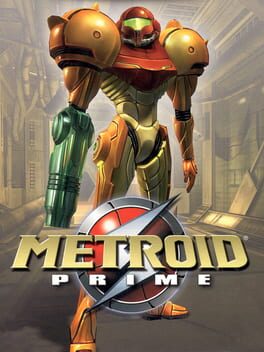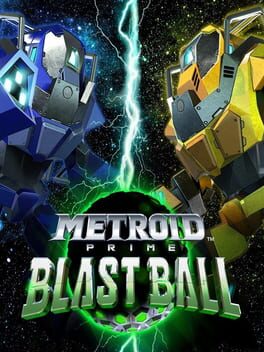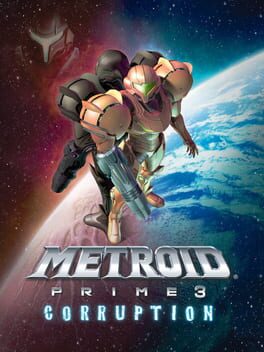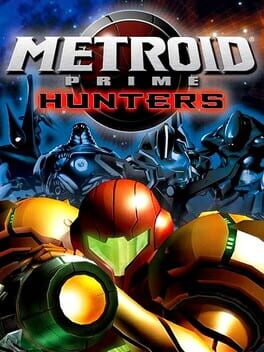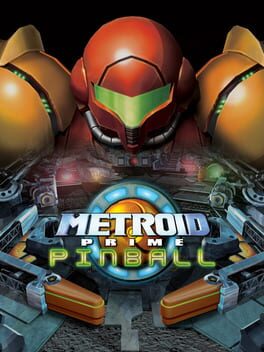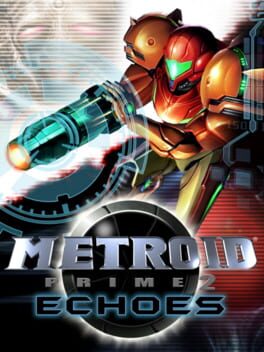

A 3D exploration-focused metroidvania with first-person shooting mechanics and the first 3D entry in the Metroid series, Metroid Prime follows Samus Aran after the events of Metroid (1986) as she boards a Space Pirate frigate, then chases her escaping archrival Ridley into the intricately structured Tallon IV, a planet full of deadly wildlife and former home to the advanced and ancient Chozo race.
Also in series
Reviews View More
This review contains spoilers
Spoiler level: High. Expect specific mechanical and story spoilers.
I played version 1.0 of the GameCube version of Metroid Prime, on a Wii, with a widescreen mod. Although I do own the game, I used Nintendont, which may have improved the game’s performance. I achieved 74% completion with most objects scanned and all but one E-tank, judging by the HUD.
The controls are passable. Tank controls may feel like an odd choice, but they are probably the best scheme that the controller could accommodate; dual-stick aiming would have heavily compromised the button mapping, and the controller’s trigger buttons would have worsened the feel of the weapons, as most sport a one-press, one-shot scheme, which keeps combat frantic and direct. The existing controls are also poorly tuned. Cycling between enemies with the lock-on is finicky at best, as is target acquisition. Weapon switch speed, while fine for combat, bogs down traversal, as all doors require the correct beam to open, even after being unlocked once. Samus also turns too slowly, feeling more like Jill Valentine than a bounty hunter.
Metroid Prime’s true zenith lies within its masterful progression and atmosphere. Samus herself demonstrates the widest gulf, granting a taste of power during the prologue before her upgrades are stripped away, then slowly expanding her capabilities until she can dispatch any enemy with ease. The world similarly shifts; initially, Samus encounters only naturalistic enemies and ancient structures, with adventurous music befitting an uninhabited planet. Over time, the Space Pirates and their modern structures eventually begin to reveal themselves, accompanied by a foreboding score. These industrial complexes present the atmospheric highlights of the game: the music pauses, the lights go dark, Samus is in trouble, and it’s up to her to turn the tables. Her actions have a real effect on the world, and eventually, the Space Pirate logs scattered throughout the world reflect this, mentioning them directly and becoming increasingly panicked over time. This holistic approach to progression sells just how much of a cannon Samus becomes: the world fears her very presence.
Combat likewise shines, with enemies that vary greatly in strength and strategy. Samus Aran’s attacks sport great depth - there are four main beams, each with a charge attack and an unlockable combo attack, missiles, and fringe attacks like the Morph Ball Bomb. Most enemies are broadly vulnerable, but certain combinations hold valuable niches; for instance, the Ice Beam and a missile can dispatch stronger enemies quickly, but only if the player develops high accuracy. Deep into the game, however, the exceptionally powerful Plasma Beam obsoletes the other options. Seemingly as a counter to this, enemies vulnerable only to specific beams are introduced, distilling their encounters to a simple weapon selection. Still, the combat remains enjoyable, if a little heavy on enemy spam near the end, treating Samus’ newfound power more as an avenue for catharsis than a game breaker.
Tallon IV’s level design is very intentional. Instead of featuring a vast world filled with grand vistas and cities, it instead mostly sports cramped indoor areas and walled-off outdoor courtyards. This is clearly a level design concession - it keeps the world’s scale in check - but it removes a sense of placeness from the world. The world also features other artificialities, such as a high amount of platforming. Initially, platforms and environmental hazards integrate with the environment, but eventually these are replaced with arbitrary floating platforms spaced just far enough apart to be cumbersome, and Samus’ lack of movement options renders them boring. Despite this, the world remains chock-full of secrets, and many of them are telegraphed well, even if they are not yet obtainable with Samus’ current gear. Overall the level design is quite palatable, keeping the pace reasonable and the brain spinning.
At least, reasonable most of the time. This game has some of the most volatile backtracking I have ever seen in a game.
Metroid Prime features no fast travel system, which is an admirable design goal, but its areas are too linear. For instance, reaching Phendrana Drifts from the Tallon Overworld presents a ten-minute-long trek, consisting largely of walking and extremely basic platforming. Samus is provided with some movement upgrades, but these save little on backtracking at best. The double jump provides decent time saves in earlier areas, but none for later areas which expect it. The Grapple Beam, conversely, is unlocked criminally late into the game, rendering it mostly useless.
Enemy progression also permeates nearly every area of the game, and while I praised it earlier, it can also turn backtracking into a chore. The worst example, Chozo Ghosts, appear throughout the Chozo Ruins later in the game. By this time, Samus is powerful enough to handily defeat them, and yet they constantly grind down the pace of backtracking. Samus also cannot reliably target them without the X-Ray visor, elevating their annoyance until it is acquired.
Additionally, the Chozo Artifacts are gated rather arbitrarily, best illustrated by the Tower of Light. A player may decide to do some early backtracking through the ruins with the knowledge that the artifact is present, reach the tower, and complete the upper section. Despite this, without the Gravity Suit, the player is pointlessly stuffed from actually obtaining the artifact, forced to spend twenty minutes returning later. It is a blatantly arbitrary lock that is unfortunately repeated elsewhere.
This all puts the player in a tough position - he or she can either backtrack early to potentially gain some artifacts and useful upgrades, but likely spend multiple extra boring hours on the game because of this, or instead the player may choose to defer backtracking until the end of the game, completely destroying the pace of the finale. This volatility has the potential to turn backtracking, which usually acts as a respite that relaxes the pace and tension, into a complete pace-breaker.
Lastly, the game suffers from a few minor oversights. While most camera controls can be inverted, the map’s controls cannot be. The map likewise suffers from a combination of transparency and poor shading, which cause frequent depth confusion. Lastly, the visor transparency setting affects both decorative and functional elements, such as the mini map, health and ammo displays, and beam selection. These should have been separate sliders.
Overall, Metroid Prime leaves me conflicted. On one hand, I love the combat, the exploration, the atmosphere, and the sense of mystery presented by the world, but on the other hand, dry backtracking and an overall lack of challenge leave it sitting somewhere short of true greatness. Still, it will easily hold one’s interest enough to see it through.
I played version 1.0 of the GameCube version of Metroid Prime, on a Wii, with a widescreen mod. Although I do own the game, I used Nintendont, which may have improved the game’s performance. I achieved 74% completion with most objects scanned and all but one E-tank, judging by the HUD.
The controls are passable. Tank controls may feel like an odd choice, but they are probably the best scheme that the controller could accommodate; dual-stick aiming would have heavily compromised the button mapping, and the controller’s trigger buttons would have worsened the feel of the weapons, as most sport a one-press, one-shot scheme, which keeps combat frantic and direct. The existing controls are also poorly tuned. Cycling between enemies with the lock-on is finicky at best, as is target acquisition. Weapon switch speed, while fine for combat, bogs down traversal, as all doors require the correct beam to open, even after being unlocked once. Samus also turns too slowly, feeling more like Jill Valentine than a bounty hunter.
Metroid Prime’s true zenith lies within its masterful progression and atmosphere. Samus herself demonstrates the widest gulf, granting a taste of power during the prologue before her upgrades are stripped away, then slowly expanding her capabilities until she can dispatch any enemy with ease. The world similarly shifts; initially, Samus encounters only naturalistic enemies and ancient structures, with adventurous music befitting an uninhabited planet. Over time, the Space Pirates and their modern structures eventually begin to reveal themselves, accompanied by a foreboding score. These industrial complexes present the atmospheric highlights of the game: the music pauses, the lights go dark, Samus is in trouble, and it’s up to her to turn the tables. Her actions have a real effect on the world, and eventually, the Space Pirate logs scattered throughout the world reflect this, mentioning them directly and becoming increasingly panicked over time. This holistic approach to progression sells just how much of a cannon Samus becomes: the world fears her very presence.
Combat likewise shines, with enemies that vary greatly in strength and strategy. Samus Aran’s attacks sport great depth - there are four main beams, each with a charge attack and an unlockable combo attack, missiles, and fringe attacks like the Morph Ball Bomb. Most enemies are broadly vulnerable, but certain combinations hold valuable niches; for instance, the Ice Beam and a missile can dispatch stronger enemies quickly, but only if the player develops high accuracy. Deep into the game, however, the exceptionally powerful Plasma Beam obsoletes the other options. Seemingly as a counter to this, enemies vulnerable only to specific beams are introduced, distilling their encounters to a simple weapon selection. Still, the combat remains enjoyable, if a little heavy on enemy spam near the end, treating Samus’ newfound power more as an avenue for catharsis than a game breaker.
Tallon IV’s level design is very intentional. Instead of featuring a vast world filled with grand vistas and cities, it instead mostly sports cramped indoor areas and walled-off outdoor courtyards. This is clearly a level design concession - it keeps the world’s scale in check - but it removes a sense of placeness from the world. The world also features other artificialities, such as a high amount of platforming. Initially, platforms and environmental hazards integrate with the environment, but eventually these are replaced with arbitrary floating platforms spaced just far enough apart to be cumbersome, and Samus’ lack of movement options renders them boring. Despite this, the world remains chock-full of secrets, and many of them are telegraphed well, even if they are not yet obtainable with Samus’ current gear. Overall the level design is quite palatable, keeping the pace reasonable and the brain spinning.
At least, reasonable most of the time. This game has some of the most volatile backtracking I have ever seen in a game.
Metroid Prime features no fast travel system, which is an admirable design goal, but its areas are too linear. For instance, reaching Phendrana Drifts from the Tallon Overworld presents a ten-minute-long trek, consisting largely of walking and extremely basic platforming. Samus is provided with some movement upgrades, but these save little on backtracking at best. The double jump provides decent time saves in earlier areas, but none for later areas which expect it. The Grapple Beam, conversely, is unlocked criminally late into the game, rendering it mostly useless.
Enemy progression also permeates nearly every area of the game, and while I praised it earlier, it can also turn backtracking into a chore. The worst example, Chozo Ghosts, appear throughout the Chozo Ruins later in the game. By this time, Samus is powerful enough to handily defeat them, and yet they constantly grind down the pace of backtracking. Samus also cannot reliably target them without the X-Ray visor, elevating their annoyance until it is acquired.
Additionally, the Chozo Artifacts are gated rather arbitrarily, best illustrated by the Tower of Light. A player may decide to do some early backtracking through the ruins with the knowledge that the artifact is present, reach the tower, and complete the upper section. Despite this, without the Gravity Suit, the player is pointlessly stuffed from actually obtaining the artifact, forced to spend twenty minutes returning later. It is a blatantly arbitrary lock that is unfortunately repeated elsewhere.
This all puts the player in a tough position - he or she can either backtrack early to potentially gain some artifacts and useful upgrades, but likely spend multiple extra boring hours on the game because of this, or instead the player may choose to defer backtracking until the end of the game, completely destroying the pace of the finale. This volatility has the potential to turn backtracking, which usually acts as a respite that relaxes the pace and tension, into a complete pace-breaker.
Lastly, the game suffers from a few minor oversights. While most camera controls can be inverted, the map’s controls cannot be. The map likewise suffers from a combination of transparency and poor shading, which cause frequent depth confusion. Lastly, the visor transparency setting affects both decorative and functional elements, such as the mini map, health and ammo displays, and beam selection. These should have been separate sliders.
Overall, Metroid Prime leaves me conflicted. On one hand, I love the combat, the exploration, the atmosphere, and the sense of mystery presented by the world, but on the other hand, dry backtracking and an overall lack of challenge leave it sitting somewhere short of true greatness. Still, it will easily hold one’s interest enough to see it through.
The decision to have a 3D Metroid game have a first-person perspective was a stroke of genius. While especially for the 2000s it would've felt like trend-chasing, one of Metroid's core pillars is its atmosphere. And they amplify this point so hard with how many environmental effects there are, between walking through stream fogging up the visor, certain enemies causing electrical interference, causing the visor's HUD to glitch and fuzz up with static, and seeing water drop down your face, all really making the visor an extension of the player experience. As corny as it is to say this, it really puts you into the shoes of a power-suit-wearing bounty hunter exploring an alien planet.
Its story really works in this atmosphere-first approach too. The only important things to know is Samus arrived to a space pirate distress signal and she's here to investigate and stop whatever they're doing, eventually leading to destroying the source of Phazon deep in an impact crater. But to get a deeper context into what's going on, you use the scan visor to read both the data logs by pirates and the lore mural left behind by Chozo, allowing the player to piece together the bigger picture themselves, and it's brilliant to make lore more or less a collectible in a game like this.
While it doesn't have the dual-stick controls FPS games usually have, it's generally balanced around how you have to stop to look around, most enemies attacking you from eye-level and having the whole lock-on feature. Using Samus' arsenal is a snap and very intuitive for a game of this age, all the beam weapons being on a c-stick direction.
And it translates the Metroidvania genre to 3D perfectly, with there being a lot of secrets to find. Scan visor and a unique humming noise helps with detecting if an expansion is hidden nearby, especially good for beginners that don't have an eye for how they like to hide things yet.
Something about this game also makes upgrades feel a little more impactful than in 2D. Individual beam upgrades is really nice, but it doesn't quite match getting Plasma Beam for the first time in this game, stepping outside where jetpack pirates are nearby and killing this enemy that was previously a huge pain in the ass in a single charge shot.
As much as I love the game, there's two fumbles that I feel like keep it from reaching perfection, that being how often it asks you to backtrack to a previous area to grab a new upgraded needed to keep progressing through the area you're already in. At its worst when you pick up Boost Ball, have to then get out of Phendrana, trek all the way through Magmoor and Chozo Ruins, all to make your way back to Tallon Overworld to take the half-pipe there to grab Space Jump and then have to walk the entire way back to where you were.
I also feel like the boss fights are really dull. Flaggrha is laughably easy, the fight mainly just taking a while because it can knock down the solar discs you took offline. Thardus spends ridiculously long periods of doing nothing and being invulnerable to damage as you repeat a cycle of using Thermal Visor to find its weak spot, crack it open, switch back to combat visor, and then finish off that weak spot, repeat half a dozen times. Omega Pirate is only slightly better because it's easier to defeat it in as little cycles as possible. Ridley is the one winner of a boss fight, barring how long he spends flying in the background doing a very obviously telegraphed missile attack. And the final boss is just free, being real. Slightly forgivable because combat isn't 100% the focus of the game, but they're still overly long and boring.
Its story really works in this atmosphere-first approach too. The only important things to know is Samus arrived to a space pirate distress signal and she's here to investigate and stop whatever they're doing, eventually leading to destroying the source of Phazon deep in an impact crater. But to get a deeper context into what's going on, you use the scan visor to read both the data logs by pirates and the lore mural left behind by Chozo, allowing the player to piece together the bigger picture themselves, and it's brilliant to make lore more or less a collectible in a game like this.
While it doesn't have the dual-stick controls FPS games usually have, it's generally balanced around how you have to stop to look around, most enemies attacking you from eye-level and having the whole lock-on feature. Using Samus' arsenal is a snap and very intuitive for a game of this age, all the beam weapons being on a c-stick direction.
And it translates the Metroidvania genre to 3D perfectly, with there being a lot of secrets to find. Scan visor and a unique humming noise helps with detecting if an expansion is hidden nearby, especially good for beginners that don't have an eye for how they like to hide things yet.
Something about this game also makes upgrades feel a little more impactful than in 2D. Individual beam upgrades is really nice, but it doesn't quite match getting Plasma Beam for the first time in this game, stepping outside where jetpack pirates are nearby and killing this enemy that was previously a huge pain in the ass in a single charge shot.
As much as I love the game, there's two fumbles that I feel like keep it from reaching perfection, that being how often it asks you to backtrack to a previous area to grab a new upgraded needed to keep progressing through the area you're already in. At its worst when you pick up Boost Ball, have to then get out of Phendrana, trek all the way through Magmoor and Chozo Ruins, all to make your way back to Tallon Overworld to take the half-pipe there to grab Space Jump and then have to walk the entire way back to where you were.
I also feel like the boss fights are really dull. Flaggrha is laughably easy, the fight mainly just taking a while because it can knock down the solar discs you took offline. Thardus spends ridiculously long periods of doing nothing and being invulnerable to damage as you repeat a cycle of using Thermal Visor to find its weak spot, crack it open, switch back to combat visor, and then finish off that weak spot, repeat half a dozen times. Omega Pirate is only slightly better because it's easier to defeat it in as little cycles as possible. Ridley is the one winner of a boss fight, barring how long he spends flying in the background doing a very obviously telegraphed missile attack. And the final boss is just free, being real. Slightly forgivable because combat isn't 100% the focus of the game, but they're still overly long and boring.
immaculate vibes, world etc and great pacing in this half but yeah the second half really lets it down, it loses the energy
collecting the artefacts made me stop playing for a bit, the game design just seems rushed,
two bosses right after each other, that both get sluggish and annoying to fight, the mechanics aren't made for the amount of metroid at the end (or maybe get gud etc)
but glad i finally got round to this, the "metroidvania" game design (which you could argue it's not I guess without the rpg elements circa tim rogers on insert credit) is a such a satisfying almost SPIRITUAL way of design approaching - thinking about ursula k le guin and the dispossed "true voyage is return" (with powerups)
collecting the artefacts made me stop playing for a bit, the game design just seems rushed,
two bosses right after each other, that both get sluggish and annoying to fight, the mechanics aren't made for the amount of metroid at the end (or maybe get gud etc)
but glad i finally got round to this, the "metroidvania" game design (which you could argue it's not I guess without the rpg elements circa tim rogers on insert credit) is a such a satisfying almost SPIRITUAL way of design approaching - thinking about ursula k le guin and the dispossed "true voyage is return" (with powerups)
